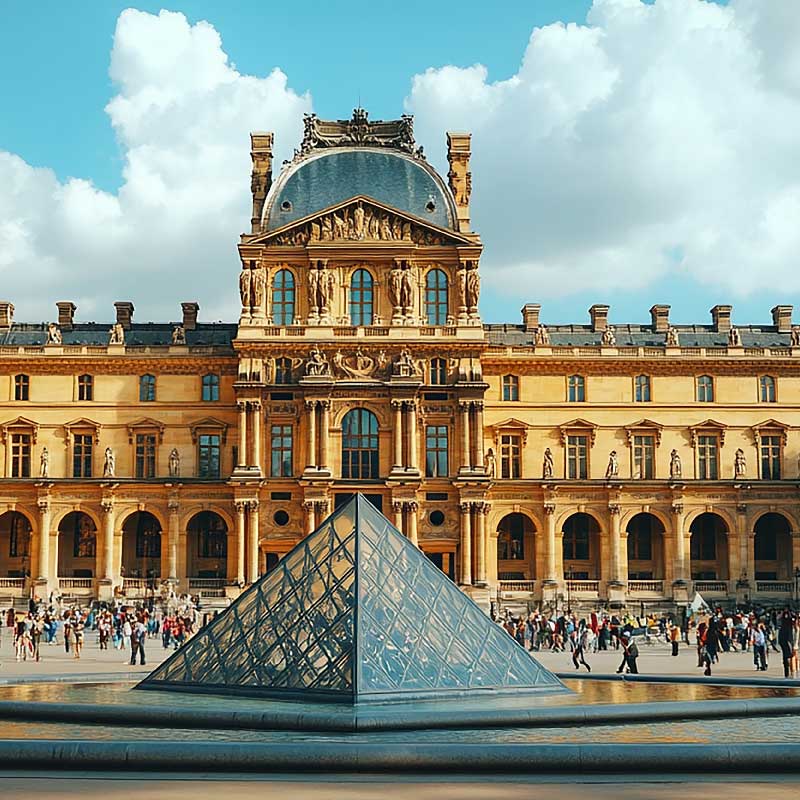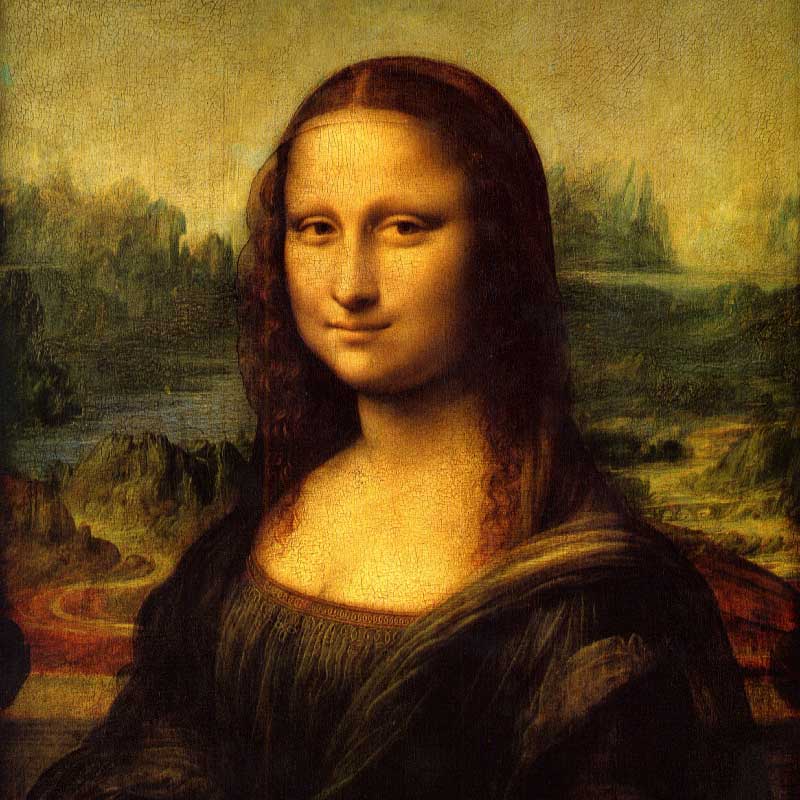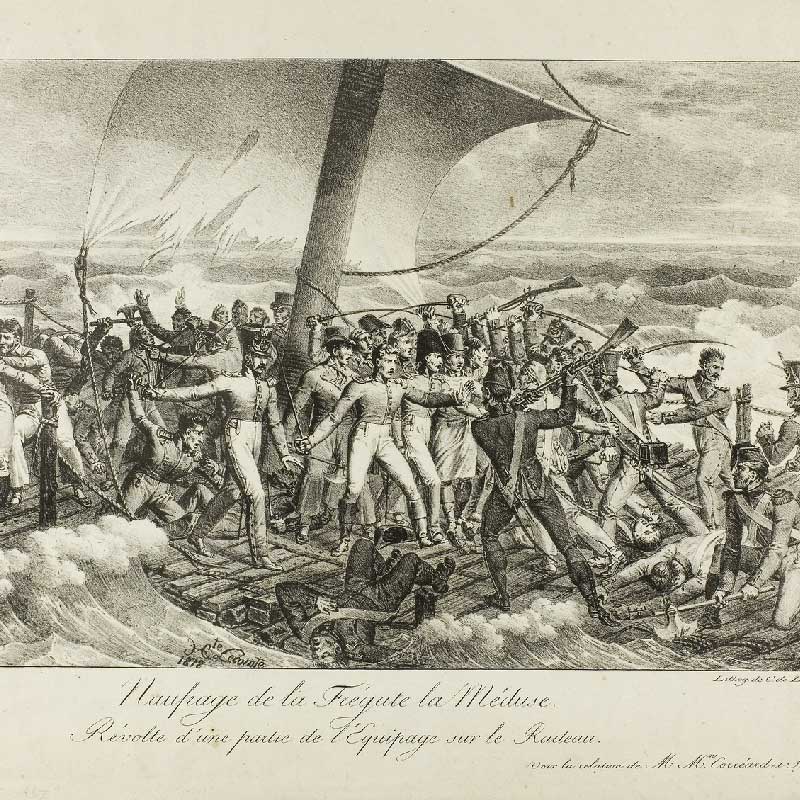The Louvre Museum is not just the world’s largest art museum; it’s a cultural phenomenon, a testament to human creativity, and a must-visit destination for art lovers. Nestled in the heart of Paris, the Louvre houses over 35,000 works of art, spanning from ancient civilizations to the 19th century. In this blog post, we’ll dive into the Louvre’s rich history, explore its most iconic masterpieces, share fun and strange facts, and uncover what makes this legendary museum so captivating.

A Glimpse into the History of the Louvre
Originally built as a fortress in 1190 under King Philip II, the Louvre transformed over the centuries into a royal palace and finally into a public museum in 1793, during the French Revolution.
The structure itself is an architectural masterpiece, combining medieval, Renaissance, and modern styles. The iconic glass pyramid, designed by architect I.M. Pei, was added in 1989 and now serves as the museum’s main entrance.
Napoleon Bonaparte significantly expanded the collection, looting treasures from across Europe during his conquests. While many pieces were returned, some, like The Wedding at Cana, remain part of the Louvre’s collection.
Famous Paintings and Artists
1. The Mona Lisa by Leonardo da Vinci

- Undoubtedly the most famous piece in the Louvre, La Gioconda attracts millions of visitors annually.
- Painted by Leonardo da Vinci in the early 1500s, the enigmatic smile and her mysterious identity have made this portrait a global icon.
- Fun Fact: It’s surprisingly small at 30 x 21 inches and is protected behind bulletproof glass.
2. The Winged Victory of Samothrace
- This stunning 2nd-century BC Greek sculpture depicts the goddess Nike (Victory) and is celebrated for its dynamic motion and detailed drapery.
- It greets visitors dramatically at the top of the Daru staircase, offering one of the most awe-inspiring views in the museum.

3. The Wedding at Cana by Paolo Veronese
- This massive painting (22 x 32 feet) depicts the biblical story of Jesus turning water into wine.
- Its scale and intricate details are breathtaking and offer insight into the opulent Venetian art of the 16th century.
- Fun Fact: It hangs directly opposite the Mona Lisa in the same gallery.
4. Liberty Leading the People by Eugène Delacroix
- A powerful symbol of revolution, this painting portrays Liberty as a goddess leading the French people to freedom during the July Revolution of 1830.
- Its bold colors and dynamic composition make it one of the most stirring pieces in the museum.
5. The Raft of the Medusa by Théodore Géricault

- Based on a tragic shipwreck, this painting combines realism and emotion, portraying survivors clinging to life.
- Fun Fact: Géricault interviewed survivors and even studied corpses to ensure accuracy.
Fun and Strange Facts About the Louvre
- It’s Bigger Than You Think:
The Louvre covers over 782,000 square feet, and seeing every piece of art would take around 100 days, assuming you spent 30 seconds on each! - A Historical Hideaway:
During WWII, the Louvre’s art collection was evacuated to secret locations to protect it from Nazi looting. - The Louvre Pyramid Controversy:
When the glass pyramid was unveiled, it faced backlash for being “too modern” for the historic site. Today, it’s one of the museum’s most iconic features. - Mona Lisa Theft:
In 1911, the Mona Lisa was stolen by an Italian handyman who believed it should return to Italy. Its two-year disappearance only heightened its fame. - The Ghost of the Louvre:
The Red Man of the Tuileries, a ghost said to haunt the grounds, is a popular legend among locals.
How to Make the Most of Your Visit
Plan Ahead:
The museum is vast, so prioritize what you want to see. Popular sections include the Denon Wing (Mona Lisa, Liberty Leading the People), the Sully Wing (Venus de Milo), and the Richelieu Wing (Napoleon’s Apartments).
Timing Is Everything:
Visit early in the morning or late in the afternoon to avoid crowds. Wednesdays and Fridays are great as the museum stays open late.
Get a Guide:
Opt for a guided tour or an audio guide to enrich your experience and learn the fascinating stories behind the artwork.
Cultural Insights: Why the Louvre Matters
The Louvre is more than an art museum—it’s a cultural treasure trove that connects us to human history. Each piece of art reflects the values, struggles, and triumphs of its time, offering a window into our collective past. The Louvre’s role in preserving and showcasing these masterpieces ensures that art continues to inspire and educate generations.
The Louvre Museum isn’t just a place to admire art; it’s a journey through time, culture, and creativity. Whether you’re captivated by the enigmatic smile of the Mona Lisa, awestruck by the grandeur of The Winged Victory, or intrigued by the museum’s hidden stories, the Louvre promises an unforgettable experience.

https://shorturl.fm/YvSxU
https://shorturl.fm/m8ueY
https://shorturl.fm/XIZGD
https://shorturl.fm/68Y8V
https://shorturl.fm/XIZGD
https://shorturl.fm/A5ni8
https://shorturl.fm/oYjg5
https://shorturl.fm/9fnIC
https://shorturl.fm/bODKa
https://shorturl.fm/oYjg5
https://shorturl.fm/YvSxU
https://shorturl.fm/68Y8V
https://shorturl.fm/bODKa
https://shorturl.fm/XIZGD
https://shorturl.fm/bODKa
https://shorturl.fm/6539m
https://shorturl.fm/YvSxU
https://shorturl.fm/FIJkD
https://shorturl.fm/5JO3e
https://shorturl.fm/a0B2m
https://shorturl.fm/YvSxU
https://shorturl.fm/YZRz9
https://shorturl.fm/uyMvT
https://shorturl.fm/eAlmd
https://shorturl.fm/YZRz9
https://shorturl.fm/TDuGJ
https://shorturl.fm/Kp34g
https://shorturl.fm/hQjgP
https://shorturl.fm/0EtO1
Promote our brand and watch your income grow—join today! https://shorturl.fm/ajiPt
Apply now and unlock exclusive affiliate rewards! https://shorturl.fm/DK3fr
Maximize your income with our high-converting offers—join as an affiliate! https://shorturl.fm/obfWd
Tap into a new revenue stream—become an affiliate partner! https://shorturl.fm/Ly8IN
Unlock exclusive rewards with every referral—apply to our affiliate program now! https://shorturl.fm/YWx7v
Start earning on every sale—become our affiliate partner today! https://shorturl.fm/GKxef
Apply now and receive dedicated support for affiliates! https://shorturl.fm/I8Fbh
Join our affiliate program and start earning today—sign up now! https://shorturl.fm/toLAd
Earn recurring commissions with each referral—enroll today! https://shorturl.fm/P0iYr
Start earning on every sale—become our affiliate partner today! https://shorturl.fm/ExVn7
Apply now and receive dedicated support for affiliates! https://shorturl.fm/Z9xp8
Share our products, reap the rewards—apply to our affiliate program! https://shorturl.fm/xRiqZ
Refer and earn up to 50% commission—join now! https://shorturl.fm/yPoQZ
Unlock exclusive rewards with every referral—enroll now! https://shorturl.fm/WxWHk
Promote our brand and watch your income grow—join today! https://shorturl.fm/WPaR3
Turn referrals into revenue—sign up for our affiliate program today! https://shorturl.fm/r54Ig
Refer friends, earn cash—sign up now! https://shorturl.fm/IaqbH
Turn referrals into revenue—sign up for our affiliate program today! https://shorturl.fm/Tj9RM
Become our affiliate—tap into unlimited earning potential! https://shorturl.fm/pR9y8
Sign up now and access top-converting affiliate offers! https://shorturl.fm/zrq9k
Join our affiliate community and maximize your profits! https://shorturl.fm/8asfx
Share our products and watch your earnings grow—join our affiliate program! https://shorturl.fm/m18u5
Monetize your influence—become an affiliate today! https://shorturl.fm/en1CK
Sign up and turn your connections into cash—join our affiliate program! https://shorturl.fm/wxbUJ
Start sharing our link and start earning today! https://shorturl.fm/OeRAl
Become our affiliate and watch your wallet grow—apply now! https://shorturl.fm/N68W4
Partner with us for generous payouts—sign up today! https://shorturl.fm/IHCtx
Monetize your traffic with our affiliate program—sign up now! https://shorturl.fm/PQo0b
Share our link, earn real money—signup for our affiliate program! https://shorturl.fm/avBeN
Get rewarded for every recommendation—join our affiliate network! https://shorturl.fm/n9Wwx
Share your unique link and earn up to 40% commission! https://shorturl.fm/bANHS
Turn referrals into revenue—sign up for our affiliate program today! https://shorturl.fm/aslKd
Join our affiliate program and watch your earnings skyrocket—sign up now! https://shorturl.fm/EiVvD
Promote our brand, reap the rewards—apply to our affiliate program today! https://shorturl.fm/VvEJs
Start profiting from your traffic—sign up today! https://shorturl.fm/iGqw3
Monetize your traffic instantly—enroll in our affiliate network! https://shorturl.fm/nkPig
Get rewarded for every recommendation—join our affiliate network! https://shorturl.fm/z0WKK
Share our products, earn up to 40% per sale—apply today! https://shorturl.fm/9tbQ8
Join our affiliate community and earn more—register now! https://shorturl.fm/aLIgr
Monetize your audience—become an affiliate partner now! https://shorturl.fm/wUSvU
Promote our brand, reap the rewards—apply to our affiliate program today! https://shorturl.fm/cXbR6
Your influence, your income—join our affiliate network today! https://shorturl.fm/SZUbM
https://shorturl.fm/M0wu5
https://shorturl.fm/Q2FY3
https://shorturl.fm/OKNv5
https://shorturl.fm/E2DLN
https://shorturl.fm/G8Drv
https://shorturl.fm/kjatN
https://shorturl.fm/8r01i
https://shorturl.fm/fYIuT
https://shorturl.fm/oMgUy
https://shorturl.fm/Wh7hx
https://shorturl.fm/f6cAZ
https://shorturl.fm/GA5XT
https://shorturl.fm/egZvR
https://shorturl.fm/tPPpn
https://shorturl.fm/eKPVF
https://shorturl.fm/j1yjN
https://shorturl.fm/mTdqB
https://shorturl.fm/wqGHD
https://shorturl.fm/vWTdw
https://shorturl.fm/vB6VN
https://shorturl.fm/CiWmN
https://shorturl.fm/v3sgP
https://shorturl.fm/Zf69I
https://shorturl.fm/8wYqS
https://shorturl.fm/ltJJS
https://shorturl.fm/goDYb
https://shorturl.fm/xmqSw
https://shorturl.fm/xmqSw
https://shorturl.fm/hpfBt
https://shorturl.fm/TsL5l
https://shorturl.fm/o9cja
https://shorturl.fm/bCeRS
https://shorturl.fm/gjBmD
https://shorturl.fm/I3mxq
https://shorturl.fm/H1vbb
https://shorturl.fm/IeJhc
https://shorturl.fm/MUSP9
https://shorturl.fm/HH3Fz
https://shorturl.fm/4eXH2
https://shorturl.fm/8OzeE
https://shorturl.fm/0rEk7
https://shorturl.fm/MypLT
https://shorturl.fm/JkkWy
https://shorturl.fm/G5NXC
https://shorturl.fm/cY5FX
https://shorturl.fm/wIoRW
https://shorturl.fm/M8lQg
https://shorturl.fm/cTGqM
https://shorturl.fm/GQrfz
https://shorturl.fm/xbdHL
https://shorturl.fm/hzvQ3
https://shorturl.fm/EEA7x
https://shorturl.fm/pTx0F
https://shorturl.fm/4npvN